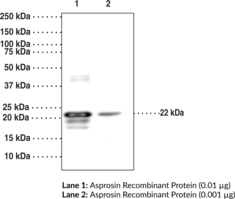Cayman
Showing 10501–10650 of 45550 results
-
Aspergillin PZ is a fungal metabolite originally isolated from A. awamori.{43853} It induces morphological deformation of P. oryzae conidia when used at a concentration of 89 nM. Aspergillin PZ is active against S. epidermidis (MIC = 20 μM) but not S. aureus, E. coli, or B. cereus (MICs = >20 μM).{43854} It is cytotoxic to HL-60 promyelocytic leukemia cells (IC50 = 56.61 μM) but not THP-1 acute monocytic leukemia or PC3 prostate cancer cells (IC50s = >80 μM).{43855}
Brand:CaymanSKU:27722 - 5 mgAvailable on backorder
Aspergillin PZ is a fungal metabolite originally isolated from A. awamori.{43853} It induces morphological deformation of P. oryzae conidia when used at a concentration of 89 nM. Aspergillin PZ is active against S. epidermidis (MIC = 20 μM) but not S. aureus, E. coli, or B. cereus (MICs = >20 μM).{43854} It is cytotoxic to HL-60 promyelocytic leukemia cells (IC50 = 56.61 μM) but not THP-1 acute monocytic leukemia or PC3 prostate cancer cells (IC50s = >80 μM).{43855}
Brand:CaymanSKU:27722 - 500 µgAvailable on backorder
Asperglaucide is an amide originally isolated from P. aurantiacum that has diverse biological activities, including anti-inflammatory, antibacterial, antioxidant, and anticancer properties.{47611,47612,47613,47614} Asperglaucide inhibits production of nitric oxide (NO), prostaglandin E2 (PGE2; Item No. 14010), and IL-1β in LPS-stimulated BV-2 microglial cells (IC50s = 49.7, 51.5, and 40.4 µM, respectively).{47612} It is active against Gram-negative bacteria (MICs = 0.05-0.10 mg/ml) and has antioxidant activity in 2,2-diphenyl-1-picrylhydrazyl (DPPH; Item No. 14805) and Trolox equivalent antioxidant capacity (TEAC) assays (EC50s = 9.51-78.81 µg/ml).{47613} Asperglaucide decreases viability of U87 and U251 cancer cells in vitro when used at concentrations ranging from 10 to 100 µM and reduces tumor growth when administered at a dose of 1 mg via intratumoral injection in a U87 mouse xenograft model.{47614}
Brand:CaymanSKU:28499 - 1 mgAvailable on backorder
Asperglaucide is an amide originally isolated from P. aurantiacum that has diverse biological activities, including anti-inflammatory, antibacterial, antioxidant, and anticancer properties.{47611,47612,47613,47614} Asperglaucide inhibits production of nitric oxide (NO), prostaglandin E2 (PGE2; Item No. 14010), and IL-1β in LPS-stimulated BV-2 microglial cells (IC50s = 49.7, 51.5, and 40.4 µM, respectively).{47612} It is active against Gram-negative bacteria (MICs = 0.05-0.10 mg/ml) and has antioxidant activity in 2,2-diphenyl-1-picrylhydrazyl (DPPH; Item No. 14805) and Trolox equivalent antioxidant capacity (TEAC) assays (EC50s = 9.51-78.81 µg/ml).{47613} Asperglaucide decreases viability of U87 and U251 cancer cells in vitro when used at concentrations ranging from 10 to 100 µM and reduces tumor growth when administered at a dose of 1 mg via intratumoral injection in a U87 mouse xenograft model.{47614}
Brand:CaymanSKU:28499 - 500 µgAvailable on backorder
Asperlactone is a nematicidal, insecticidal, antibacterial, and antifungal polyketide metabolite produced from A. westerdijkiae.{22543}
Brand:CaymanSKU:-Asperlactone is a nematicidal, insecticidal, antibacterial, and antifungal polyketide metabolite produced from A. westerdijkiae.{22543}
Brand:CaymanSKU:-Asperphenamate is a fungal secondary metabolite originally isolated from A. flavipes.{39753} It inhibits proliferation of T47D and MDA-MB-231 breast and HL-60 leukemia cancer cell lines (IC50s = 92.3, 96.5, and 97.9 μM, respectively) and inhibits yeast α-glucosidase activity (IC50 = 8.3 μM).{39754,43022}
Brand:CaymanSKU:25086 - 1 mgAvailable on backorder
Asperphenamate is a fungal secondary metabolite originally isolated from A. flavipes.{39753} It inhibits proliferation of T47D and MDA-MB-231 breast and HL-60 leukemia cancer cell lines (IC50s = 92.3, 96.5, and 97.9 μM, respectively) and inhibits yeast α-glucosidase activity (IC50 = 8.3 μM).{39754,43022}
Brand:CaymanSKU:25086 - 5 mgAvailable on backorder
Asperuloside is an iridoid glycoside that has been found in G. tunetanum and has diverse biological activities, including anti-angiogenic, anti-inflammatory, and anti-obesity properties.{48785,48786,48787} It reduces microvessel formation by 67% in a chick embryo chorioallantoic membrane assay when used at a concentration of 2 μg/egg.{48785} Asperuloside (20, 40, and 80 mg/L) inhibits LPS-induced increases in TNF-α, IL-1β, and IL-6 production in RAW 264.7 macrophages in a concentration-dependent manner.{48786} It reduces lung myeloperoxidase (MPO) activity and bronchoalveolar lavage fluid (BALF) levels of TNF-α, IL-1β, and IL-6 in a mouse model of LPS-induced acute lung injury when administered at doses of 20, 40, and 80 mg/kg. Dietary administration of asperuloside decreases body weight gain, white adipose tissue (WAT) weight, and the ratio of WAT weight to body weight in a high-fat diet-induced mouse model of metabolic syndrome.{48787}
Brand:CaymanSKU:29439 - 1 mgAvailable on backorder
Asperuloside is an iridoid glycoside that has been found in G. tunetanum and has diverse biological activities, including anti-angiogenic, anti-inflammatory, and anti-obesity properties.{48785,48786,48787} It reduces microvessel formation by 67% in a chick embryo chorioallantoic membrane assay when used at a concentration of 2 μg/egg.{48785} Asperuloside (20, 40, and 80 mg/L) inhibits LPS-induced increases in TNF-α, IL-1β, and IL-6 production in RAW 264.7 macrophages in a concentration-dependent manner.{48786} It reduces lung myeloperoxidase (MPO) activity and bronchoalveolar lavage fluid (BALF) levels of TNF-α, IL-1β, and IL-6 in a mouse model of LPS-induced acute lung injury when administered at doses of 20, 40, and 80 mg/kg. Dietary administration of asperuloside decreases body weight gain, white adipose tissue (WAT) weight, and the ratio of WAT weight to body weight in a high-fat diet-induced mouse model of metabolic syndrome.{48787}
Brand:CaymanSKU:29439 - 10 mgAvailable on backorder
Asperuloside is an iridoid glycoside that has been found in G. tunetanum and has diverse biological activities, including anti-angiogenic, anti-inflammatory, and anti-obesity properties.{48785,48786,48787} It reduces microvessel formation by 67% in a chick embryo chorioallantoic membrane assay when used at a concentration of 2 μg/egg.{48785} Asperuloside (20, 40, and 80 mg/L) inhibits LPS-induced increases in TNF-α, IL-1β, and IL-6 production in RAW 264.7 macrophages in a concentration-dependent manner.{48786} It reduces lung myeloperoxidase (MPO) activity and bronchoalveolar lavage fluid (BALF) levels of TNF-α, IL-1β, and IL-6 in a mouse model of LPS-induced acute lung injury when administered at doses of 20, 40, and 80 mg/kg. Dietary administration of asperuloside decreases body weight gain, white adipose tissue (WAT) weight, and the ratio of WAT weight to body weight in a high-fat diet-induced mouse model of metabolic syndrome.{48787}
Brand:CaymanSKU:29439 - 25 mgAvailable on backorder
Asperuloside is an iridoid glycoside that has been found in G. tunetanum and has diverse biological activities, including anti-angiogenic, anti-inflammatory, and anti-obesity properties.{48785,48786,48787} It reduces microvessel formation by 67% in a chick embryo chorioallantoic membrane assay when used at a concentration of 2 μg/egg.{48785} Asperuloside (20, 40, and 80 mg/L) inhibits LPS-induced increases in TNF-α, IL-1β, and IL-6 production in RAW 264.7 macrophages in a concentration-dependent manner.{48786} It reduces lung myeloperoxidase (MPO) activity and bronchoalveolar lavage fluid (BALF) levels of TNF-α, IL-1β, and IL-6 in a mouse model of LPS-induced acute lung injury when administered at doses of 20, 40, and 80 mg/kg. Dietary administration of asperuloside decreases body weight gain, white adipose tissue (WAT) weight, and the ratio of WAT weight to body weight in a high-fat diet-induced mouse model of metabolic syndrome.{48787}
Brand:CaymanSKU:29439 - 5 mgAvailable on backorder
Aspirin is a non-selective, irreversible COX inhibitor. The IC50 values for ovine COX-1 and -2 are 0.75 and 1.25 mM, respectively.{1364} Aspirin acetylates COX-1 at Ser530 and COX-2 at Ser516 resulting in irreversible enzyme inhibition.
Brand:CaymanSKU:70260 - 100 gAvailable on backorder
Aspirin is a non-selective, irreversible COX inhibitor. The IC50 values for ovine COX-1 and -2 are 0.75 and 1.25 mM, respectively.{1364} Aspirin acetylates COX-1 at Ser530 and COX-2 at Ser516 resulting in irreversible enzyme inhibition.
Brand:CaymanSKU:70260 - 50 gAvailable on backorder
Aspirin is a non-selective, irreversible COX inhibitor. The IC50 values for ovine COX-1 and -2 are 0.75 and 1.25 mM, respectively.{1364} Aspirin acetylates COX-1 at Ser530 and COX-2 at Ser516 resulting in irreversible enzyme inhibition.
Brand:CaymanSKU:70260 - 500 gAvailable on backorder
Aspirin-d4 is intended for use as an internal standard for the quantification of aspirin (Item No. 70260) by GC- or LC-MS. Aspirin is a non-selective, irreversible COX inhibitor. The IC50 values for ovine COX-1 and -2 are 0.75 and 1.25 mM, respectively.{1364} Aspirin acetylates COX-1 at Ser530 and COX-2 at Ser516 resulting in irreversible enzyme inhibition.
Brand:CaymanSKU:-Available on backorder
Aspirin-d4 is intended for use as an internal standard for the quantification of aspirin (Item No. 70260) by GC- or LC-MS. Aspirin is a non-selective, irreversible COX inhibitor. The IC50 values for ovine COX-1 and -2 are 0.75 and 1.25 mM, respectively.{1364} Aspirin acetylates COX-1 at Ser530 and COX-2 at Ser516 resulting in irreversible enzyme inhibition.
Brand:CaymanSKU:-Available on backorder
Aspirin-d4 is intended for use as an internal standard for the quantification of aspirin (Item No. 70260) by GC- or LC-MS. Aspirin is a non-selective, irreversible COX inhibitor. The IC50 values for ovine COX-1 and -2 are 0.75 and 1.25 mM, respectively.{1364} Aspirin acetylates COX-1 at Ser530 and COX-2 at Ser516 resulting in irreversible enzyme inhibition.
Brand:CaymanSKU:-Available on backorder
Aspochalasin D is a co-metabolite originally isolated from A. microcysticus with aspochalasins A, B, and C, that was initially thought to be inactive.{38485} It has antibacterial activity against Gram-positive and Gram-negative bacteria at a concentration of 1 mg/ml.{38484} Aspochalasin D is more cytotoxic, via apoptosis, to Ba/F3-V12 cells in an IL-3-free medium than in an IL-3-containing medium (IC50s = 0.49 and 1.9 µg/ml, respectively).{38486}
Brand:CaymanSKU:23864 - 1 mgAvailable on backorder
Aspochalasin D is a co-metabolite originally isolated from A. microcysticus with aspochalasins A, B, and C, that was initially thought to be inactive.{38485} It has antibacterial activity against Gram-positive and Gram-negative bacteria at a concentration of 1 mg/ml.{38484} Aspochalasin D is more cytotoxic, via apoptosis, to Ba/F3-V12 cells in an IL-3-free medium than in an IL-3-containing medium (IC50s = 0.49 and 1.9 µg/ml, respectively).{38486}
Brand:CaymanSKU:23864 - 5 mgAvailable on backorder
Aspochalasin M is a fungal metabolite originally isolated from S. elegans.{43043} It inhibits the growth of HL-60 cells (IC50 = 20 µM) but not MOLT-4, A549, or BEL-7402 cells (IC50s = >100 µg/ml).
Brand:CaymanSKU:25087 - 2.5 mgAvailable on backorder
Aspochalasin M is a fungal metabolite originally isolated from S. elegans.{43043} It inhibits the growth of HL-60 cells (IC50 = 20 µM) but not MOLT-4, A549, or BEL-7402 cells (IC50s = >100 µg/ml).
Brand:CaymanSKU:25087 - 500 µgAvailable on backorder
Aspochracin is a cyclic tripeptide originally isolated from the pathogenic fungus A. ochraceus, which infects insects.{35219} Aspochracin is toxic to fall webworms (LD50 = 100 µg/g) and to silkworms.{35219,35221} Unlike other aspochracin-type cyclic tripeptides, it has no antifungal activity against C. albicans and does not have antimicrobial activity up to a concentration of 0.1 mg/ml.{40471,35219}
Brand:CaymanSKU:23914 - 2.5 mgAvailable on backorder
Aspochracin is a cyclic tripeptide originally isolated from the pathogenic fungus A. ochraceus, which infects insects.{35219} Aspochracin is toxic to fall webworms (LD50 = 100 µg/g) and to silkworms.{35219,35221} Unlike other aspochracin-type cyclic tripeptides, it has no antifungal activity against C. albicans and does not have antimicrobial activity up to a concentration of 0.1 mg/ml.{40471,35219}
Brand:CaymanSKU:23914 - 500 µgAvailable on backorder
Asprosin is a glucogenic protein hormone secreted by white adipose tissue in mammals.{31498} This ~16 kDa protein is a 140 amino acid C-terminal cleavage product produced by furin cleavage of profibrillin. Asprosin increases glucose release via cyclic AMP (cAMP) and protein kinase A (PKA) in hepatocytes via interaction with a cell surface receptor, an effect that can be reversed by suramin, an inhibitor of heterotrimeric G proteins, or Rp-cAMPS (Item No. 16985), an antagonist of cAMP binding to PKA. In vivo, elevated plasma asprosin increases hepatic glucose production but does not affect glucose uptake in peripheral organs in response to insulin. Asprosin is orexigenic, activating AgRP+ neurons in a cAMP-dependent manner which leads to appetite stimulation and increased body weight.{37364} Plasma asprosin is elevated in adult humans and mice with type 2 diabetes mellitus and other genetic conditions that confer insulin resistance.{31498},{37365} Cayman’s Asprosin Polyclonal Antibody can be used for Western blot and immunoprecipitation.
Brand:CaymanSKU:23857 - 300 µgAvailable on backorder
Immunogen: Human recombinant protein • Host: Rabbit • Species Reactivity: (+) Human asprosin • Applications: IP, WB
Brand:CaymanSKU:23857- 300 µgAvailable on backorder
Immunogen: Human recombinant protein • Host: Rabbit • Species Reactivity: (+) Human asprosin • Applications: IP, WB
Brand:CaymanSKU:23857- 300 µgAspterric acid is a carotene-type sesquiterpene, plant growth regulator, and inhibitor of pollen development originally isolated from the fungus A. terreus.{36893,36894} It inhibits pollen development, reduces stem length at first flowering, and increases the time to bolting and first flowering in A. thaliana when used at a concentration of 38 μM.{36893} Aspterric acid exerts its effects on reproductive growth in A. thaliana without inhibiting biosynthesis and transport of the plant growth regulator indole-3-acetic acid (Item No. 16954).{36894}
Brand:CaymanSKU:25919 - 1 mgAvailable on backorder
Aspulvinone O is a fungal metabolite that has been found in P. variotti and has antioxidant and anticancer activities.{46739,46740} It scavenges 2,2-diphenyl-1-picrylhydrazyl (DPPH; Item No. 14805) radicals in a cell-free assay (IC50 = 11.6 µM).{46739} Aspulvinone O inhibits aspartate transaminase 1 (GOT1; Kd = 3.32 µM) and is cytotoxic to PANC-1, AsPC-1, and SW1990 pancreatic cancer cells (IC50s = 20.54-26.8 µM).{46740} It reduces the oxygen consumption rate (OCR) and induces apoptosis in SW1990 cells. Aspulvinone O (2.5 and 5 mg/kg) reduces tumor growth in an SW1990 mouse xenograft model.
Brand:CaymanSKU:29959 - 1 mgAvailable on backorder
Aspulvinone O is a fungal metabolite that has been found in P. variotti and has antioxidant and anticancer activities.{46739,46740} It scavenges 2,2-diphenyl-1-picrylhydrazyl (DPPH; Item No. 14805) radicals in a cell-free assay (IC50 = 11.6 µM).{46739} Aspulvinone O inhibits aspartate transaminase 1 (GOT1; Kd = 3.32 µM) and is cytotoxic to PANC-1, AsPC-1, and SW1990 pancreatic cancer cells (IC50s = 20.54-26.8 µM).{46740} It reduces the oxygen consumption rate (OCR) and induces apoptosis in SW1990 cells. Aspulvinone O (2.5 and 5 mg/kg) reduces tumor growth in an SW1990 mouse xenograft model.
Brand:CaymanSKU:29959 - 5 mgAvailable on backorder
Aspyrone is a polyketide fungal metabolite that has been found in Aspergillus and has diverse biological activities.{54304,54303} It is active against a panel of 13 fungi when used at a concentration of 20 µg/ml and a panel of 21 bacteria in a disc assay when used at a concentration of 100 µg per disc.{54304} Aspyrone (10-1,000 mg/L) is nematocidal against P. penetrans.{54303}
Brand:CaymanSKU:31389 - 1 mgAvailable on backorder
Aspyrone is a polyketide fungal metabolite that has been found in Aspergillus and has diverse biological activities.{54304,54303} It is active against a panel of 13 fungi when used at a concentration of 20 µg/ml and a panel of 21 bacteria in a disc assay when used at a concentration of 100 µg per disc.{54304} Aspyrone (10-1,000 mg/L) is nematocidal against P. penetrans.{54303}
Brand:CaymanSKU:31389 - 5 mgAvailable on backorder
Brand:CaymanSKU:760114 - 1 eaAvailable on backorder
AST-1306 is an irreversible inhibitor of EGFR, HER2, and HER4 (IC50s = 0.5, 3, and 0.8 nM, respectively).{48897} It is selective for EGFR, HER2, and HER4 over a panel of 23 additional kinases (IC50s = >10 µM). AST-1306 also inhibits EGFRT790M/L858R with an IC50 value of 12 nM in a cell-free assay. It decreases EGFR, ERK1/2, and Akt phosphorylation in Calu-3, A549, and SKOV3 cancer cells when used at concentrations ranging from 0.001 to 1 µM. AST-1306 inhibits proliferation of Calu-3, BT474, MDA-MB-468, A549, SKOV3, NCI H23, and MCF-7 cells (IC50s = 0.23-16 µM). It reduces tumor growth in Calu-3, A549, SKOV3, and HO8910 mouse xenograft models when administered at doses of 25, 50, and 100 mg/kg per day.
Brand:CaymanSKU:29708 - 1 mgAvailable on backorder
AST-1306 is an irreversible inhibitor of EGFR, HER2, and HER4 (IC50s = 0.5, 3, and 0.8 nM, respectively).{48897} It is selective for EGFR, HER2, and HER4 over a panel of 23 additional kinases (IC50s = >10 µM). AST-1306 also inhibits EGFRT790M/L858R with an IC50 value of 12 nM in a cell-free assay. It decreases EGFR, ERK1/2, and Akt phosphorylation in Calu-3, A549, and SKOV3 cancer cells when used at concentrations ranging from 0.001 to 1 µM. AST-1306 inhibits proliferation of Calu-3, BT474, MDA-MB-468, A549, SKOV3, NCI H23, and MCF-7 cells (IC50s = 0.23-16 µM). It reduces tumor growth in Calu-3, A549, SKOV3, and HO8910 mouse xenograft models when administered at doses of 25, 50, and 100 mg/kg per day.
Brand:CaymanSKU:29708 - 10 mgAvailable on backorder
AST-1306 is an irreversible inhibitor of EGFR, HER2, and HER4 (IC50s = 0.5, 3, and 0.8 nM, respectively).{48897} It is selective for EGFR, HER2, and HER4 over a panel of 23 additional kinases (IC50s = >10 µM). AST-1306 also inhibits EGFRT790M/L858R with an IC50 value of 12 nM in a cell-free assay. It decreases EGFR, ERK1/2, and Akt phosphorylation in Calu-3, A549, and SKOV3 cancer cells when used at concentrations ranging from 0.001 to 1 µM. AST-1306 inhibits proliferation of Calu-3, BT474, MDA-MB-468, A549, SKOV3, NCI H23, and MCF-7 cells (IC50s = 0.23-16 µM). It reduces tumor growth in Calu-3, A549, SKOV3, and HO8910 mouse xenograft models when administered at doses of 25, 50, and 100 mg/kg per day.
Brand:CaymanSKU:29708 - 25 mgAvailable on backorder
AST-1306 is an irreversible inhibitor of EGFR, HER2, and HER4 (IC50s = 0.5, 3, and 0.8 nM, respectively).{48897} It is selective for EGFR, HER2, and HER4 over a panel of 23 additional kinases (IC50s = >10 µM). AST-1306 also inhibits EGFRT790M/L858R with an IC50 value of 12 nM in a cell-free assay. It decreases EGFR, ERK1/2, and Akt phosphorylation in Calu-3, A549, and SKOV3 cancer cells when used at concentrations ranging from 0.001 to 1 µM. AST-1306 inhibits proliferation of Calu-3, BT474, MDA-MB-468, A549, SKOV3, NCI H23, and MCF-7 cells (IC50s = 0.23-16 µM). It reduces tumor growth in Calu-3, A549, SKOV3, and HO8910 mouse xenograft models when administered at doses of 25, 50, and 100 mg/kg per day.
Brand:CaymanSKU:29708 - 5 mgAvailable on backorder
AST-487 is an inhibitor of RET (IC50 = 0.88 µM), FLT3 (Ki = 0.52 µM), KDR (IC50 = 0.17 µM), c-Abl (IC50 = 0.02 µM), and c-Kit (IC50 = 0.5 µM).{31675,31676} It has been shown to inhibit RET autophosphorylation and activation of downstream effectors and to prevent the growth of human thyroid cancer cell lines with activating mutations of RET but not of lines without RET mutations.{31675} In xenografts of NIH3T3 cells expressing oncogenic RET and of the MTC cell line TT in nude mice, AST-487 dose dependently inhibited tumor growth.{31675} It also demonstrates antiproliferative effects on primary cells from acute myelocytic leukemia patients and on cell lines expressing FLT3-ITD or FLT3 kinase domain point mutants.{31675}
Brand:CaymanSKU:-Available on backorder
AST-487 is an inhibitor of RET (IC50 = 0.88 µM), FLT3 (Ki = 0.52 µM), KDR (IC50 = 0.17 µM), c-Abl (IC50 = 0.02 µM), and c-Kit (IC50 = 0.5 µM).{31675,31676} It has been shown to inhibit RET autophosphorylation and activation of downstream effectors and to prevent the growth of human thyroid cancer cell lines with activating mutations of RET but not of lines without RET mutations.{31675} In xenografts of NIH3T3 cells expressing oncogenic RET and of the MTC cell line TT in nude mice, AST-487 dose dependently inhibited tumor growth.{31675} It also demonstrates antiproliferative effects on primary cells from acute myelocytic leukemia patients and on cell lines expressing FLT3-ITD or FLT3 kinase domain point mutants.{31675}
Brand:CaymanSKU:-Available on backorder
AST-487 is an inhibitor of RET (IC50 = 0.88 µM), FLT3 (Ki = 0.52 µM), KDR (IC50 = 0.17 µM), c-Abl (IC50 = 0.02 µM), and c-Kit (IC50 = 0.5 µM).{31675,31676} It has been shown to inhibit RET autophosphorylation and activation of downstream effectors and to prevent the growth of human thyroid cancer cell lines with activating mutations of RET but not of lines without RET mutations.{31675} In xenografts of NIH3T3 cells expressing oncogenic RET and of the MTC cell line TT in nude mice, AST-487 dose dependently inhibited tumor growth.{31675} It also demonstrates antiproliferative effects on primary cells from acute myelocytic leukemia patients and on cell lines expressing FLT3-ITD or FLT3 kinase domain point mutants.{31675}
Brand:CaymanSKU:-Available on backorder
AST-487 is an inhibitor of RET (IC50 = 0.88 µM), FLT3 (Ki = 0.52 µM), KDR (IC50 = 0.17 µM), c-Abl (IC50 = 0.02 µM), and c-Kit (IC50 = 0.5 µM).{31675,31676} It has been shown to inhibit RET autophosphorylation and activation of downstream effectors and to prevent the growth of human thyroid cancer cell lines with activating mutations of RET but not of lines without RET mutations.{31675} In xenografts of NIH3T3 cells expressing oncogenic RET and of the MTC cell line TT in nude mice, AST-487 dose dependently inhibited tumor growth.{31675} It also demonstrates antiproliferative effects on primary cells from acute myelocytic leukemia patients and on cell lines expressing FLT3-ITD or FLT3 kinase domain point mutants.{31675}
Brand:CaymanSKU:-Available on backorder
Astaxanthin is a carotenoid pigment found primarily in marine animals including shrimp and salmon. It is a potent lipid-soluble antioxidant.{8149}
Brand:CaymanSKU:70685 - 25 mgAvailable on backorder
Astaxanthin is a carotenoid pigment found primarily in marine animals including shrimp and salmon. It is a potent lipid-soluble antioxidant.{8149}
Brand:CaymanSKU:70685 - 5 mgAvailable on backorder
Astemizole is a non-sedating antihistamine that antagonizes the histamine H1 receptor with a Ki value of 4.4 nM.{25629} It is considerably less potent at muscarinic acetylcholine receptors (Ki = 2.4 µM).{23214} Astemizole is also a potent blocker of ether-a-go-go-related gene (ERG) potassium channels (IC50 = ~1 nM) that has been used to study long QT syndrome type 2.{24505,24504} Furthermore, because it can target oncogenic ERG1 and ERG potassium channels, astemizole has been explored as a potential antineoplastic agent for decreasing proliferation of various cancer cells.{27578}
Brand:CaymanSKU:-Out of stock
Astemizole is a non-sedating antihistamine that antagonizes the histamine H1 receptor with a Ki value of 4.4 nM.{25629} It is considerably less potent at muscarinic acetylcholine receptors (Ki = 2.4 µM).{23214} Astemizole is also a potent blocker of ether-a-go-go-related gene (ERG) potassium channels (IC50 = ~1 nM) that has been used to study long QT syndrome type 2.{24505,24504} Furthermore, because it can target oncogenic ERG1 and ERG potassium channels, astemizole has been explored as a potential antineoplastic agent for decreasing proliferation of various cancer cells.{27578}
Brand:CaymanSKU:-Out of stock
Astemizole is a non-sedating antihistamine that antagonizes the histamine H1 receptor with a Ki value of 4.4 nM.{25629} It is considerably less potent at muscarinic acetylcholine receptors (Ki = 2.4 µM).{23214} Astemizole is also a potent blocker of ether-a-go-go-related gene (ERG) potassium channels (IC50 = ~1 nM) that has been used to study long QT syndrome type 2.{24505,24504} Furthermore, because it can target oncogenic ERG1 and ERG potassium channels, astemizole has been explored as a potential antineoplastic agent for decreasing proliferation of various cancer cells.{27578}
Brand:CaymanSKU:-Out of stock
Asterric acid is an antibiotic fungal metabolite that completely inhibits the binding of the potent vasoconstrictor endothelin (ET)-1 to the ETA receptor in A10 cells at 0.1 μM.{1209} Asterric acid derivatives have also been shown to inhibit VEGF-induced tube formation of human umbilical vein endothelial cells at 3-10 μM, which suggests its usefulness as an antiangiogenic agent.{25064}
Brand:CaymanSKU:70630 - 1 mgAvailable on backorder
Asterric acid is an antibiotic fungal metabolite that completely inhibits the binding of the potent vasoconstrictor endothelin (ET)-1 to the ETA receptor in A10 cells at 0.1 μM.{1209} Asterric acid derivatives have also been shown to inhibit VEGF-induced tube formation of human umbilical vein endothelial cells at 3-10 μM, which suggests its usefulness as an antiangiogenic agent.{25064}
Brand:CaymanSKU:70630 - 5 mgAvailable on backorder
Asterriquinol D dimethyl ether is a fungal metabolite that has been found in A. kumbius.{39715} It is cytotoxic to NS-1 mouse myeloma cells (IC50 = 28 μg/ml) and has activity against T. foetus in vitro (IC50 = 100 μg/ml).
Brand:CaymanSKU:25080 - 1 mgAvailable on backorder
Asterriquinol D dimethyl ether is a fungal metabolite that has been found in A. kumbius.{39715} It is cytotoxic to NS-1 mouse myeloma cells (IC50 = 28 μg/ml) and has activity against T. foetus in vitro (IC50 = 100 μg/ml).
Brand:CaymanSKU:25080 - 5 mgAvailable on backorder
Astilbin is a flavonoid that has been found in S. glabra and has diverse biological activities.{48502,48503,48504} It inhibits cisplatin-induced increases in apoptosis and accumulation of reactive oxygen species (ROS) in HEK293 cells when used at a concentration of 200 μM.{48502} Astilbin (50 mg/kg) increases renal glutathione (GSH) levels and superoxide dismutase (SOD) and catalase activity and reduces serum creatinine and blood urea nitrogen (BUN) levels, renal IL-1β, IL-6, and TNF-α levels, apoptosis in kidney tissue, and kidney injury in a mouse model of cisplatin-induced nephrotoxicity. It reduces loss of dopaminergic neurons in the substantia nigra and increases striatal GSH levels and SOD activity in a mouse model of MPTP-induced Parkinson’s disease when administered at a dose of 50 mg/kg per day.{48503} Astilbin also reduces descent time in a pole test and increases traction test score in a mouse model of Parkinson’s disease, indicating reduced motor deficits. It reduces cell viability of MDA-MB-231 and MCF-7 cells (IC50s = 167.9 and 191.6 μM, respectively), as well as inhibits migration and increases apoptosis when used at concentrations of 50 and 200 μM.{48504} Astilbin (20 mg/kg every other day for 14 days) reduces tumor growth in an MCF-7 mouse xenograft model.
Brand:CaymanSKU:28267 - 10 mgAvailable on backorder
Astilbin is a flavonoid that has been found in S. glabra and has diverse biological activities.{48502,48503,48504} It inhibits cisplatin-induced increases in apoptosis and accumulation of reactive oxygen species (ROS) in HEK293 cells when used at a concentration of 200 μM.{48502} Astilbin (50 mg/kg) increases renal glutathione (GSH) levels and superoxide dismutase (SOD) and catalase activity and reduces serum creatinine and blood urea nitrogen (BUN) levels, renal IL-1β, IL-6, and TNF-α levels, apoptosis in kidney tissue, and kidney injury in a mouse model of cisplatin-induced nephrotoxicity. It reduces loss of dopaminergic neurons in the substantia nigra and increases striatal GSH levels and SOD activity in a mouse model of MPTP-induced Parkinson’s disease when administered at a dose of 50 mg/kg per day.{48503} Astilbin also reduces descent time in a pole test and increases traction test score in a mouse model of Parkinson’s disease, indicating reduced motor deficits. It reduces cell viability of MDA-MB-231 and MCF-7 cells (IC50s = 167.9 and 191.6 μM, respectively), as well as inhibits migration and increases apoptosis when used at concentrations of 50 and 200 μM.{48504} Astilbin (20 mg/kg every other day for 14 days) reduces tumor growth in an MCF-7 mouse xenograft model.
Brand:CaymanSKU:28267 - 100 mgAvailable on backorder
Astilbin is a flavonoid that has been found in S. glabra and has diverse biological activities.{48502,48503,48504} It inhibits cisplatin-induced increases in apoptosis and accumulation of reactive oxygen species (ROS) in HEK293 cells when used at a concentration of 200 μM.{48502} Astilbin (50 mg/kg) increases renal glutathione (GSH) levels and superoxide dismutase (SOD) and catalase activity and reduces serum creatinine and blood urea nitrogen (BUN) levels, renal IL-1β, IL-6, and TNF-α levels, apoptosis in kidney tissue, and kidney injury in a mouse model of cisplatin-induced nephrotoxicity. It reduces loss of dopaminergic neurons in the substantia nigra and increases striatal GSH levels and SOD activity in a mouse model of MPTP-induced Parkinson’s disease when administered at a dose of 50 mg/kg per day.{48503} Astilbin also reduces descent time in a pole test and increases traction test score in a mouse model of Parkinson’s disease, indicating reduced motor deficits. It reduces cell viability of MDA-MB-231 and MCF-7 cells (IC50s = 167.9 and 191.6 μM, respectively), as well as inhibits migration and increases apoptosis when used at concentrations of 50 and 200 μM.{48504} Astilbin (20 mg/kg every other day for 14 days) reduces tumor growth in an MCF-7 mouse xenograft model.
Brand:CaymanSKU:28267 - 25 mgAvailable on backorder
Astilbin is a flavonoid that has been found in S. glabra and has diverse biological activities.{48502,48503,48504} It inhibits cisplatin-induced increases in apoptosis and accumulation of reactive oxygen species (ROS) in HEK293 cells when used at a concentration of 200 μM.{48502} Astilbin (50 mg/kg) increases renal glutathione (GSH) levels and superoxide dismutase (SOD) and catalase activity and reduces serum creatinine and blood urea nitrogen (BUN) levels, renal IL-1β, IL-6, and TNF-α levels, apoptosis in kidney tissue, and kidney injury in a mouse model of cisplatin-induced nephrotoxicity. It reduces loss of dopaminergic neurons in the substantia nigra and increases striatal GSH levels and SOD activity in a mouse model of MPTP-induced Parkinson’s disease when administered at a dose of 50 mg/kg per day.{48503} Astilbin also reduces descent time in a pole test and increases traction test score in a mouse model of Parkinson’s disease, indicating reduced motor deficits. It reduces cell viability of MDA-MB-231 and MCF-7 cells (IC50s = 167.9 and 191.6 μM, respectively), as well as inhibits migration and increases apoptosis when used at concentrations of 50 and 200 μM.{48504} Astilbin (20 mg/kg every other day for 14 days) reduces tumor growth in an MCF-7 mouse xenograft model.
Brand:CaymanSKU:28267 - 5 mgAvailable on backorder
Astragalosides are bioactive saponins isolated from dried roots of plants of the genus Astragalus, which is used in traditional Chinese medicine.{27380} Astragaloside A is known to have diverse protective effects for the cardiovascular, immune, digestive, and nervous systems.{27380,26141} More specifically, it protects cardiomyocytes from apoptosis resulting from ischemia/reperfusion and inhibits inflammation signaled through TNF-α.{27384,27381} Furthermore, astragaloside A stimulates angiogenesis, promotes the differentiation of neural stem cells, and increases neuroregeneration.{26141,27382,27383}
Brand:CaymanSKU:-Out of stock
Astragalosides are bioactive saponins isolated from dried roots of plants of the genus Astragalus, which is used in traditional Chinese medicine.{27380} Astragaloside A is known to have diverse protective effects for the cardiovascular, immune, digestive, and nervous systems.{27380,26141} More specifically, it protects cardiomyocytes from apoptosis resulting from ischemia/reperfusion and inhibits inflammation signaled through TNF-α.{27384,27381} Furthermore, astragaloside A stimulates angiogenesis, promotes the differentiation of neural stem cells, and increases neuroregeneration.{26141,27382,27383}
Brand:CaymanSKU:-Out of stock
Astragalosides are bioactive saponins isolated from dried roots of plants of the genus Astragalus, which is used in traditional Chinese medicine.{27380} Astragaloside A is known to have diverse protective effects for the cardiovascular, immune, digestive, and nervous systems.{27380,26141} More specifically, it protects cardiomyocytes from apoptosis resulting from ischemia/reperfusion and inhibits inflammation signaled through TNF-α.{27384,27381} Furthermore, astragaloside A stimulates angiogenesis, promotes the differentiation of neural stem cells, and increases neuroregeneration.{26141,27382,27383}
Brand:CaymanSKU:-Out of stock
Astragalosides are bioactive saponins isolated from dried roots of plants of the genus Astragalus, which is used in traditional Chinese medicine.{27380} Astragaloside A is known to have diverse protective effects for the cardiovascular, immune, digestive, and nervous systems.{27380,26141} More specifically, it protects cardiomyocytes from apoptosis resulting from ischemia/reperfusion and inhibits inflammation signaled through TNF-α.{27384,27381} Furthermore, astragaloside A stimulates angiogenesis, promotes the differentiation of neural stem cells, and increases neuroregeneration.{26141,27382,27383}
Brand:CaymanSKU:-Out of stock
Astragaloside I is a saponin originally isolated from the dried plant roots of Astragalus, which is used in traditional Chinese medicine.{27380} Astragaloside I has osteogenic activities in vitro.{38156} It induces differentiation and matrix mineralization of MC3T3-E1 cells, a murine osteoblastic cell line, and increases alkaline phosphatase activity. It also increases the expression of osteoblast-related genes in a concentration-dependent manner (10-40 µM), including genes in the Wnt/β-catenin pathway.
Brand:CaymanSKU:22431 -Out of stock
Astragaloside I is a saponin originally isolated from the dried plant roots of Astragalus, which is used in traditional Chinese medicine.{27380} Astragaloside I has osteogenic activities in vitro.{38156} It induces differentiation and matrix mineralization of MC3T3-E1 cells, a murine osteoblastic cell line, and increases alkaline phosphatase activity. It also increases the expression of osteoblast-related genes in a concentration-dependent manner (10-40 µM), including genes in the Wnt/β-catenin pathway.
Brand:CaymanSKU:22431 -Out of stock
Astragaloside I is a saponin originally isolated from the dried plant roots of Astragalus, which is used in traditional Chinese medicine.{27380} Astragaloside I has osteogenic activities in vitro.{38156} It induces differentiation and matrix mineralization of MC3T3-E1 cells, a murine osteoblastic cell line, and increases alkaline phosphatase activity. It also increases the expression of osteoblast-related genes in a concentration-dependent manner (10-40 µM), including genes in the Wnt/β-catenin pathway.
Brand:CaymanSKU:22431 -Out of stock
Astragaloside I is a saponin originally isolated from the dried plant roots of Astragalus, which is used in traditional Chinese medicine.{27380} Astragaloside I has osteogenic activities in vitro.{38156} It induces differentiation and matrix mineralization of MC3T3-E1 cells, a murine osteoblastic cell line, and increases alkaline phosphatase activity. It also increases the expression of osteoblast-related genes in a concentration-dependent manner (10-40 µM), including genes in the Wnt/β-catenin pathway.
Brand:CaymanSKU:22431 -Out of stock
Astragaloside III is a saponin first isolated from the dried plant roots of the genus Astragalus, which is used in traditional Chinese medicine.{27380} It is bioavailable after oral administration, distributed mainly to the thymus and spleen, and has a half-life of approximately 2 hours.{35036,35037}
Brand:CaymanSKU:22432 -Out of stock
Astragaloside III is a saponin first isolated from the dried plant roots of the genus Astragalus, which is used in traditional Chinese medicine.{27380} It is bioavailable after oral administration, distributed mainly to the thymus and spleen, and has a half-life of approximately 2 hours.{35036,35037}
Brand:CaymanSKU:22432 -Out of stock
Astragaloside III is a saponin first isolated from the dried plant roots of the genus Astragalus, which is used in traditional Chinese medicine.{27380} It is bioavailable after oral administration, distributed mainly to the thymus and spleen, and has a half-life of approximately 2 hours.{35036,35037}
Brand:CaymanSKU:22432 -Out of stock
Astragaloside III is a saponin first isolated from the dried plant roots of the genus Astragalus, which is used in traditional Chinese medicine.{27380} It is bioavailable after oral administration, distributed mainly to the thymus and spleen, and has a half-life of approximately 2 hours.{35036,35037}
Brand:CaymanSKU:22432 -Out of stock
Astragaloside IV is a bioactive saponin first isolated from the dried plant roots of the genus Astragalus, which is used in traditional Chinese medicine.{27380} It dose-dependently inhibits human adenovirus type 3 (HAdV-3) in A549 cells (IC50 = 23 µM; LC50 = 865 µM).{34673} It inhibits replication of HAdV-3 and decreases HAdV-3-induced apoptosis. It has diverse protective effects for the cardiovascular, immune, digestive, and nervous systems.{27380,34672} In particular, it reduces myocardial infarct size in dogs when administered prior to coronary ligation and reduces reperfusion arrhythmias in isolated rat hearts.{34674}
Brand:CaymanSKU:12069 - 1 mgAvailable on backorder
Astragaloside IV is a bioactive saponin first isolated from the dried plant roots of the genus Astragalus, which is used in traditional Chinese medicine.{27380} It dose-dependently inhibits human adenovirus type 3 (HAdV-3) in A549 cells (IC50 = 23 µM; LC50 = 865 µM).{34673} It inhibits replication of HAdV-3 and decreases HAdV-3-induced apoptosis. It has diverse protective effects for the cardiovascular, immune, digestive, and nervous systems.{27380,34672} In particular, it reduces myocardial infarct size in dogs when administered prior to coronary ligation and reduces reperfusion arrhythmias in isolated rat hearts.{34674}
Brand:CaymanSKU:12069 - 10 mgAvailable on backorder
Astragaloside IV is a bioactive saponin first isolated from the dried plant roots of the genus Astragalus, which is used in traditional Chinese medicine.{27380} It dose-dependently inhibits human adenovirus type 3 (HAdV-3) in A549 cells (IC50 = 23 µM; LC50 = 865 µM).{34673} It inhibits replication of HAdV-3 and decreases HAdV-3-induced apoptosis. It has diverse protective effects for the cardiovascular, immune, digestive, and nervous systems.{27380,34672} In particular, it reduces myocardial infarct size in dogs when administered prior to coronary ligation and reduces reperfusion arrhythmias in isolated rat hearts.{34674}
Brand:CaymanSKU:12069 - 25 mgAvailable on backorder
Astragaloside IV is a bioactive saponin first isolated from the dried plant roots of the genus Astragalus, which is used in traditional Chinese medicine.{27380} It dose-dependently inhibits human adenovirus type 3 (HAdV-3) in A549 cells (IC50 = 23 µM; LC50 = 865 µM).{34673} It inhibits replication of HAdV-3 and decreases HAdV-3-induced apoptosis. It has diverse protective effects for the cardiovascular, immune, digestive, and nervous systems.{27380,34672} In particular, it reduces myocardial infarct size in dogs when administered prior to coronary ligation and reduces reperfusion arrhythmias in isolated rat hearts.{34674}
Brand:CaymanSKU:12069 - 5 mgAvailable on backorder
Astringin is a phenolic stilbene glucoside that has been found in V. vinifera and has antioxidant and antineoplastic activities.{50296,50297} It scavenges 2,2-diphenyl-1-picrylhydrazyl (DPPH; Item No. 14805) radicals (IC50 = 30.2 μM) in a cell-free assay and inhibits cupric ion-induced lipid peroxidation of human LDL (IC50 = 3 μM).{50296} Astringin (10 µg/ml) inhibits development of preneoplastic lesions induced by 7,12-dimethylbenz(a)anthracene (DMBA) in mouse mammary gland organ cultures by 68.8%.{50297}
Brand:CaymanSKU:27979 - 1 mgAvailable on backorder
Astringin is a phenolic stilbene glucoside that has been found in V. vinifera and has antioxidant and antineoplastic activities.{50296,50297} It scavenges 2,2-diphenyl-1-picrylhydrazyl (DPPH; Item No. 14805) radicals (IC50 = 30.2 μM) in a cell-free assay and inhibits cupric ion-induced lipid peroxidation of human LDL (IC50 = 3 μM).{50296} Astringin (10 µg/ml) inhibits development of preneoplastic lesions induced by 7,12-dimethylbenz(a)anthracene (DMBA) in mouse mammary gland organ cultures by 68.8%.{50297}
Brand:CaymanSKU:27979 - 10 mgAvailable on backorder
Astringin is a phenolic stilbene glucoside that has been found in V. vinifera and has antioxidant and antineoplastic activities.{50296,50297} It scavenges 2,2-diphenyl-1-picrylhydrazyl (DPPH; Item No. 14805) radicals (IC50 = 30.2 μM) in a cell-free assay and inhibits cupric ion-induced lipid peroxidation of human LDL (IC50 = 3 μM).{50296} Astringin (10 µg/ml) inhibits development of preneoplastic lesions induced by 7,12-dimethylbenz(a)anthracene (DMBA) in mouse mammary gland organ cultures by 68.8%.{50297}
Brand:CaymanSKU:27979 - 25 mgAvailable on backorder
Astringin is a phenolic stilbene glucoside that has been found in V. vinifera and has antioxidant and antineoplastic activities.{50296,50297} It scavenges 2,2-diphenyl-1-picrylhydrazyl (DPPH; Item No. 14805) radicals (IC50 = 30.2 μM) in a cell-free assay and inhibits cupric ion-induced lipid peroxidation of human LDL (IC50 = 3 μM).{50296} Astringin (10 µg/ml) inhibits development of preneoplastic lesions induced by 7,12-dimethylbenz(a)anthracene (DMBA) in mouse mammary gland organ cultures by 68.8%.{50297}
Brand:CaymanSKU:27979 - 5 mgAvailable on backorder
Asukamycin is polyketide isolated from the S. nodosus subspecies asukaensis that demonstrates a broad range of antibiotic functions. It has been shown to inhibit growth of various tumor cell lines (IC50s = 1-5 µM) by activating caspases 8 and 3.{31687}
Brand:CaymanSKU:20133 -Available on backorder
Asukamycin is polyketide isolated from the S. nodosus subspecies asukaensis that demonstrates a broad range of antibiotic functions. It has been shown to inhibit growth of various tumor cell lines (IC50s = 1-5 µM) by activating caspases 8 and 3.{31687}
Brand:CaymanSKU:20133 -Available on backorder
Asunaprevir is an inhibitor of the hepatitis C non-structural 3/4A serine protease, which is required for viral replication.{32953} It is a direct-acting inhibitor of hepatitis C virus (HCV).{32953,32952} It is commonly used in combination with daclatasvir and beclabuvir, which are also direct-acting HCV inhibitors.{32953}
Brand:CaymanSKU:20835 -Out of stock
Asunaprevir is an inhibitor of the hepatitis C non-structural 3/4A serine protease, which is required for viral replication.{32953} It is a direct-acting inhibitor of hepatitis C virus (HCV).{32953,32952} It is commonly used in combination with daclatasvir and beclabuvir, which are also direct-acting HCV inhibitors.{32953}
Brand:CaymanSKU:20835 -Out of stock
Asunaprevir is an inhibitor of the hepatitis C non-structural 3/4A serine protease, which is required for viral replication.{32953} It is a direct-acting inhibitor of hepatitis C virus (HCV).{32953,32952} It is commonly used in combination with daclatasvir and beclabuvir, which are also direct-acting HCV inhibitors.{32953}
Brand:CaymanSKU:20835 -Out of stock
Asunaprevir is an inhibitor of the hepatitis C non-structural 3/4A serine protease, which is required for viral replication.{32953} It is a direct-acting inhibitor of hepatitis C virus (HCV).{32953,32952} It is commonly used in combination with daclatasvir and beclabuvir, which are also direct-acting HCV inhibitors.{32953}
Brand:CaymanSKU:20835 -Out of stock
Aszonalenin is a hexahydropyrrolo[2,3-b]indole-containing fungal metabolite produced by A. zonatus and N. tatenoi.{41719,41720}
Brand:CaymanSKU:25018 - 1 mgAvailable on backorder





























